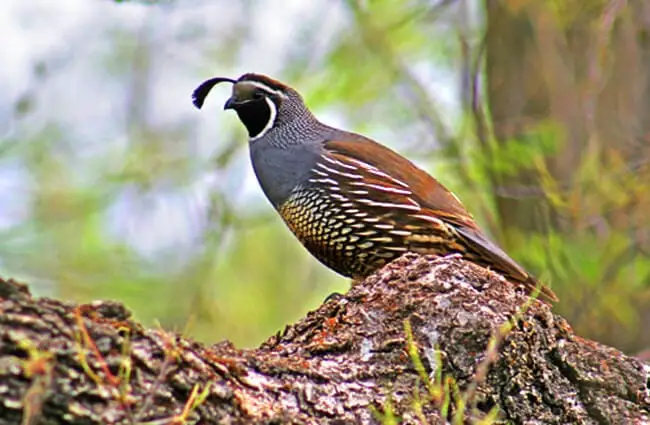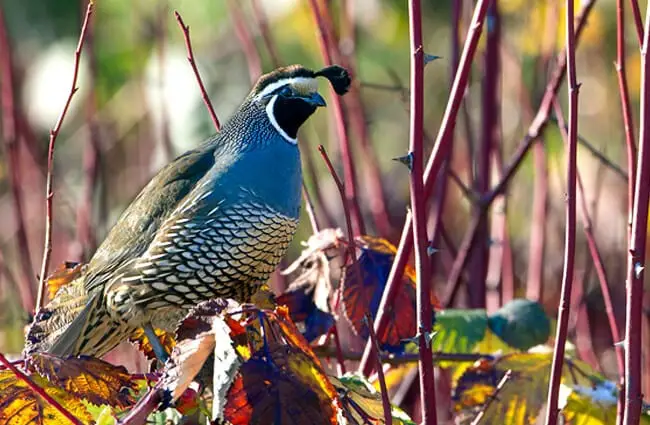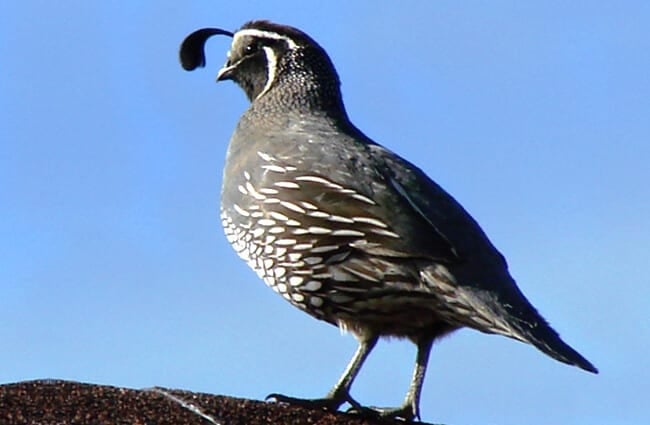Introducing the California Quail
The California Quail, Callipepla californica, is a captivating bird renowned for its sociable nature and distinctive appearance. A common sight across western North America, this ground-dwelling bird plays a vital role in its ecosystem and holds a special place in the hearts of birdwatchers and nature enthusiasts. This comprehensive guide delves into the fascinating world of the California Quail, covering its habitat, behavior, life cycle, and ecological significance.

Physical Characteristics
The California Quail is a plump, medium-sized bird, typically measuring between 9 and 11 inches in length. Its most striking feature is the elegant, forward-curving plume, or crest, atop its head. This crest is more prominent in males and can be raised or lowered depending on the bird’s mood. The plumage is generally a mottled gray-brown, providing excellent camouflage in its preferred habitats. Males boast a richer coloration with a dark brown throat patch and more vibrant markings, while females are typically more subdued. A key identifier is the scaled appearance of their flanks, resembling miniature shields.
Habitat and Distribution
California Quails are widespread across western North America, ranging from southwestern Canada to Baja California, and extending eastward to parts of Nevada, Utah, and Arizona. They exhibit remarkable adaptability, thriving in a diverse range of habitats. Common environments include chaparral, oak woodlands, grasslands, and even suburban gardens. Essential habitat features include dense shrubbery for cover, open areas for foraging, and a reliable water source. They prefer areas with a mix of habitats, providing options for feeding, nesting, and evading predators.

Diet and Foraging Behavior
California Quails are primarily ground foragers, feeding on a varied diet of seeds, grains, leaves, berries, and insects. Their diet changes seasonally, with seeds and grains forming the bulk of their intake during the fall and winter. Insects become more important during the breeding season, providing essential protein for developing chicks. They are opportunistic feeders and will readily consume agricultural crops if available. Quail are often observed in groups, collectively scratching and pecking at the ground in search of food.
Social Behavior and Life Cycle
California Quails are exceptionally social birds, famous for forming large groups called coveys. Coveys provide safety in numbers, enhancing predator detection and confusing potential attackers. These groups can range from a few individuals to over fifty birds, particularly during the non-breeding season. During the breeding season, pairs will establish territories within the covey’s range.

Mating and Reproduction
The breeding season typically occurs from February to July, varying with latitude and environmental conditions. Males attract females through elaborate displays involving vocalizations, strutting, and feather fluffing. They may engage in ritualized chasing and displays of dominance. Once paired, the birds build a shallow nest concealed amongst dense vegetation. The nest is usually a simple depression lined with grasses, leaves, and other soft materials. Females typically lay between 12 and 16 eggs, incubated for approximately 22 to 23 days. Chicks are precocial, meaning they are relatively mature at hatching and can walk and forage shortly after emerging from the egg. Both parents participate in caring for the chicks, protecting them from predators and guiding them to food sources. The young remain with the covey for several months, learning essential survival skills.
Ecological Role and Interactions
California Quails play a vital role in their ecosystem. They are important seed dispersers, contributing to plant propagation. Their foraging activities help to control insect populations. They also serve as prey for a variety of predators, including hawks, falcons, coyotes, foxes, and snakes. This makes them an important link in the food chain.

Interactions with Other Animals
Beyond predator-prey dynamics, California Quails interact with other bird species. They sometimes forage alongside other ground-feeding birds, and their presence can influence the behavior of other wildlife. They also contribute to the health of plant communities through seed dispersal and foraging activity.
California Quail and Human Interactions
California Quails have a long history of interaction with humans. They are popular game birds, attracting hunters across their range. They are also valued for their aesthetic appeal and are often observed in gardens and parks. Agricultural practices can impact quail populations, both positively and negatively. Habitat loss and fragmentation pose significant threats. Conservation efforts, such as habitat restoration and responsible land management, are crucial for ensuring the long-term survival of these charming birds.

Finding California Quail
If you are hoping to spot a California Quail in the wild, focus on areas with dense shrubbery and open grasslands. Look for signs of their presence, such as tracks, droppings, or feathers. Listen for their distinctive calls, a series of rapid, musical whistles. They are most active during the day and can often be observed foraging in small groups. Be patient and observant, and you are likely to be rewarded with a sighting of these delightful birds.
Caring for California Quail in Captivity
For zookeepers or aviculturists caring for California Quail, providing a spacious enclosure with a mix of dense vegetation, open areas, and dust bathing opportunities is essential. A varied diet of seeds, grains, greens, and insects should be provided. Ensuring a clean and sanitary environment is crucial for preventing disease. Regular health checks and veterinary care are also important. Avoid overcrowding, as this can lead to stress and aggression. Providing enrichment activities, such as foraging toys and opportunities for dust bathing, can enhance their well-being.

Interesting Facts
- California Quails are known for their running ability, often preferring to run rather than fly.
- They have a unique ability to raise and lower the crest on their heads, depending on their mood and the surrounding environment.
- Their coveys often roost together in a circle, with the birds facing outwards to provide better protection from predators.
- The call of the California Quail is often described as a cheerful “chi-ca-go” sound.
- They play a role in controlling insect populations, helping to maintain the health of ecosystems.

Conclusion
The California Quail is a captivating and ecologically important bird. Its charming appearance, social behavior, and vital role in its ecosystem make it a truly remarkable species. By understanding and appreciating these fascinating birds, we can contribute to their conservation and ensure that they continue to thrive for generations to come.

![Red Angus Closeup of a beautiful Red Angus cowPhoto by: U.S. Department of Agriculture [pubic domain]https://creativecommons.org/licenses/by/2.0/](https://animals.net/wp-content/uploads/2020/03/Red-Angus-4-238x178.jpg)




![Red Angus Closeup of a beautiful Red Angus cowPhoto by: U.S. Department of Agriculture [pubic domain]https://creativecommons.org/licenses/by/2.0/](https://animals.net/wp-content/uploads/2020/03/Red-Angus-4-100x75.jpg)

